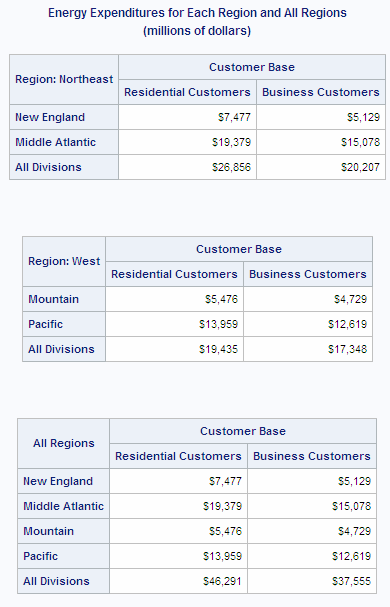TABULATE Procedure
- Syntax

- Overview
- Concepts
- Using
- Results
- Examples
 Creating a Basic Two-Dimensional TableSpecifying Class Variable Combinations to Appear in a TableUsing Preloaded Formats with Class VariablesUsing Multilabel FormatsCustomizing Row and Column HeadingsSummarizing Information with the Universal Class Variable ALLEliminating Row HeadingsIndenting Row Headings and Eliminating Horizontal SeparatorsCreating Multipage TablesReporting on Multiple-Response Survey DataReporting on Multiple-Choice Survey DataCalculating Various Percentage StatisticsUsing Denominator Definitions to Display Basic Frequency Counts and PercentagesSpecifying Style Elements for ODS OutputStyle PrecedenceNOCELLMERGE Option
Creating a Basic Two-Dimensional TableSpecifying Class Variable Combinations to Appear in a TableUsing Preloaded Formats with Class VariablesUsing Multilabel FormatsCustomizing Row and Column HeadingsSummarizing Information with the Universal Class Variable ALLEliminating Row HeadingsIndenting Row Headings and Eliminating Horizontal SeparatorsCreating Multipage TablesReporting on Multiple-Response Survey DataReporting on Multiple-Choice Survey DataCalculating Various Percentage StatisticsUsing Denominator Definitions to Display Basic Frequency Counts and PercentagesSpecifying Style Elements for ODS OutputStyle PrecedenceNOCELLMERGE Option - References
Example 9: Creating Multipage Tables
| Features: |
|
| Data set: | ENERGY |
| Formats: | REGFMT. |
Program
proc tabulate data=energy format=dollar12.;
class region division type;
var expenditures;
table region='Region: ' all='All Regions',
division all='All Divisions',
type='Customer Base'*expenditures=' '*sum=' '
/ rts=25 box=_page_ condense indent=1;
format region regfmt. division divfmt. type usetype.;
title 'Energy Expenditures for Each Region and All Regions'; title2 '(millions of dollars)'; run;
Program Description
Specify the table options.The
FORMAT= option specifies DOLLAR12. as the default format for the value
in each table cell.
Specify subgroups for the analysis.The CLASS statement identifies Region, Division,
and Type as class variables.
Specify the analysis variable.The
VAR statement specifies that PROC TABULATE calculate statistics on
the Expenditures variable.
Define the table pages.The
page dimension of the TABLE statement creates one table for each formatted
value of Region and one table for all regions. Text in quotation marks
provides the heading for each page.
Define the table rows.The
row dimension creates a row for each formatted value of Division and
a row for all divisions. Text in quotation marks provides the row
headings.
Define the table columns.The
column dimension of the TABLE statement creates a column for each
formatted value of Type. Each cell that is created by these pages,
rows, and columns contains the sum of the analysis variable Expenditures
for all observations that contribute to that cell. Text in quotation
marks specifies headings for the corresponding variable or statistic.
Although Sum is the default statistic, it is specified here so that
you can specify a blank for its heading.
Specify additional table options.RTS= provides 25 characters per line for row headings.
BOX= places the page heading inside the box above the row headings.
CONDENSE places as many tables as possible on one physical page. INDENT=
eliminates the row heading for Division. (Because there is no nesting
in the row dimension, there is nothing to indent.)
